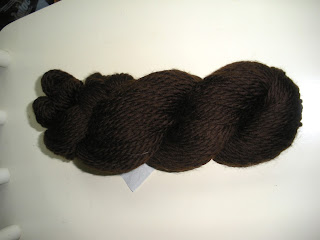In double knitting, the back of the project is the photo-negative of the front. Astronomers use photo negatives to look at stars more easily. My husband is an astronomer. Ergo, I would make him a reversible hat that would show the moon and stars, and would be an astronomy negative on the inside. Since he is always cold, I would give it earflaps. And, just to add a bit of color, The ear flaps would portray a sunset.
I used MacStitch to design the moon, and I also added a shooting star. The stars themselves would be individual stitches placed somewhat randomly in the knitting.
I picked out my yarn: black (of course) and a variegated gray that I had to give the moon (and the negative) some texture. Since it was fingering weight, I doubled it to make worsted-weight yarn.
 |
| A good color for a moon? |
Mostly, it was simply poor planning. The pattern looked great! But I spent so much time thinking about the colorwork that I managed to make a mis-shapen thing that could only generously be called a hat.
 |
| Would you wear this? |
I never got around to ripping it out. I was so annoyed that I had spent all that time for nothing, that I was disgusted with the project. I didn't want to keep working on the sign of my incompetence. But I wasn't actually willing to pull it apart either.
So...
Today I thought I would have another go at it. I ripped back to the edge of the crown and carefully put it on a needle, looked at some patterns for earflap hats (to get a better sense of proportions) and got to work.
I hadn't recorded what needle I used, so I guessed a 7, but otherwise, there haven't been any major snags. It was a bit hard to figure out where the round starts too, but not impossible. It took awhile to get all of the stitches on the needle in the right order (double knitting means twice as many), but I am well on my way.
With a little distance from the disaster, it feels less like I wasted a ton of time, and more like a salvageable learning experiment.
My other colorwork hat that I have been working on is done. I will post on it when I have the pictures up.




















































